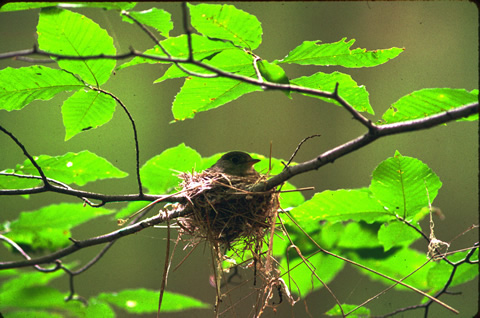My dissertation,
The Effects of
Forest Management Practices on the Reproductive Success of Neotropical
Migrant Birds in South-central Indiana.

|
Photo by Gabe Harp
|
The nest to the right belongs to a Wood Thrush (Hylocichla
mustelina). The blue egg is hers, as are the two hatchlings.
The brown-spotted egg was laid by a Brown-headed Cowbird (Molothrus
ater).
Brown-headed Cowbirds are brood parasites, meaning they lay their eggs
in the nests of other birds. Many species of nesting birds will
raise the cowbird young, suffering reduced breeding success as a
consequence.
Human land use patterns affect the abundance and breeding success of
forest birds. For instance, the Wood Thrush tends to nest in
mature forest. Cowbirds
fly into the forest from roosting areas in the morning. There
they display and interact with each other and watch for potential
hosts. In the afternoon cowbirds fly to agricultural lands and
lawns to feed, sometimes commuting 5 km or more between breeding and
feeding areas.

|
Photo by Don Whitehead
|
The Acadian Flycatcher (Empidonax virescens) breeds in forests
of the eastern United States and winters in Central and South America.
As with other Neotropical migrant birds,
the population dynamics of this species may be affected by conditions
in any part of its range.
Clearing of tropical forests may affect survival over winter.
Conversion of migratory staging areas along coasts and large
lakes to human land uses may affect migrants' chances of completing
their strenuous
flights. Fragmentation of temperate forests in eastern North Amerca may
affect habitat
availability and quality.
Some species of Neotropical migrants have shown declining trends in
recent decades, as indicated by data from the Breeding Bird Survey.
Researchers are studying the demography of these species
throughout the
hemisphere. My colleagues and I study how human land use patterns
and forest management practices affect the abundance and breeding
success of Neotropical migrant species, such as the Acadian Flycatcher
and the Wood Thrush.


